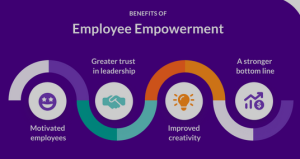Employee empowerment and motivation are two critical elements in creating a positive and high-performing work environment. Let’s explore each of these concepts:

Employee Empowerment and Motivation
Table of Contents
ToggleEmployee Empowerment:
1. Definition: Employee empowerment involves granting employees the autonomy, authority, and resources to make decisions and take initiative in their work. It’s about trusting employees to contribute meaningfully and make a difference.
2. Key Elements:
- Decision-Making Authority: Empowered employees have the freedom to make decisions related to their roles.
- Access to Information: Providing employees with the necessary information to understand the bigger picture and make informed choices.
- Skill Development: Investing in training and development to enhance skills and confidence.
- Responsibility: Entrusting employees with responsibilities that align with their capabilities and aspirations.
3. Benefits:
- Increased Job Satisfaction: Empowered employees find greater satisfaction in their work.
- Innovation: Empowered individuals are more likely to bring fresh ideas and innovative solutions.
- Higher Engagement: Feeling a sense of ownership boosts employee engagement.
- Adaptability: Empowered employees are better equipped to adapt to change.
4. Challenges:
- Balancing Control: Ensuring a balance between empowerment and maintaining necessary controls.
- Training Needs: Providing ongoing training to support empowered roles.
- Risk of Failure: Acknowledging that empowerment comes with the risk of occasional mistakes.
Employee Motivation:
1. Definition: Employee motivation involves the factors that drive individuals to perform their best at work. It’s the internal and external influences that stimulate enthusiasm, persistence, and effort toward achieving goals.
2. Key Elements:
- Recognition and Rewards: Acknowledging and rewarding employees for their contributions.
- Meaningful Work: Connecting employees to the larger purpose and impact of their work.
- Career Development: Providing opportunities for growth and advancement.
- Supportive Management: Leadership that encourages, supports, and communicates effectively.
- Positive Work Environment: A workplace that fosters collaboration, trust, and respect.
3. Benefits:
- Increased Productivity: Motivated employees are more likely to be productive.
- Higher Job Satisfaction: Motivated individuals find greater satisfaction in their roles.
- Better Employee Well-being: Motivated employees often experience lower stress levels.
- Improved Team Dynamics: Motivated team members contribute positively to the overall team atmosphere.
4. Challenges:
- Individual Differences: Different employees are motivated by different factors.
- Changing Needs: Motivational factors may evolve over time.
- External Factors: Economic conditions or personal circumstances can impact motivation.
Integration:
1. Synergy:
- Empowerment and motivation work hand in hand. Empowering employees by giving them control over their work can be a motivational factor in itself.
- Recognizing and rewarding empowered actions contributes to sustained motivation.
2. Communication:
- Regular and transparent communication is crucial to ensure that empowered individuals understand their impact and feel motivated to continue contributing.
3. Feedback:
- Providing constructive feedback helps employees understand the connection between their efforts, achievements, and the organization’s goals, fostering both empowerment and motivation.
In conclusion, combining employee empowerment with motivation creates a powerful synergy, leading to a workforce that is not only capable and confident but also driven to achieve excellence. Organizations that prioritize both empower and motivate their employees tend to foster a culture of continuous improvement and success.
